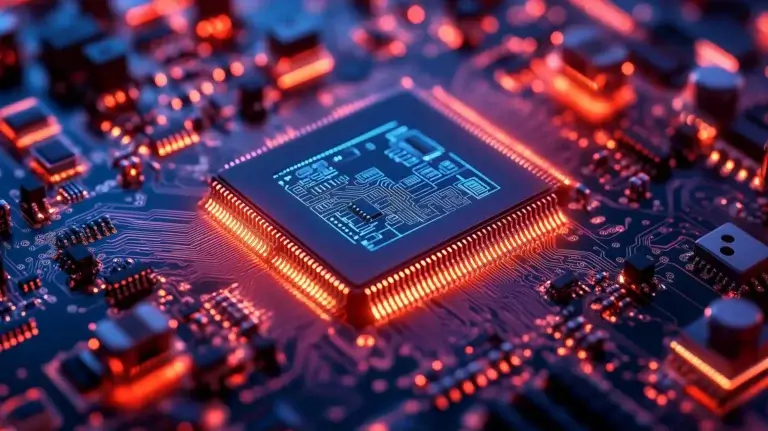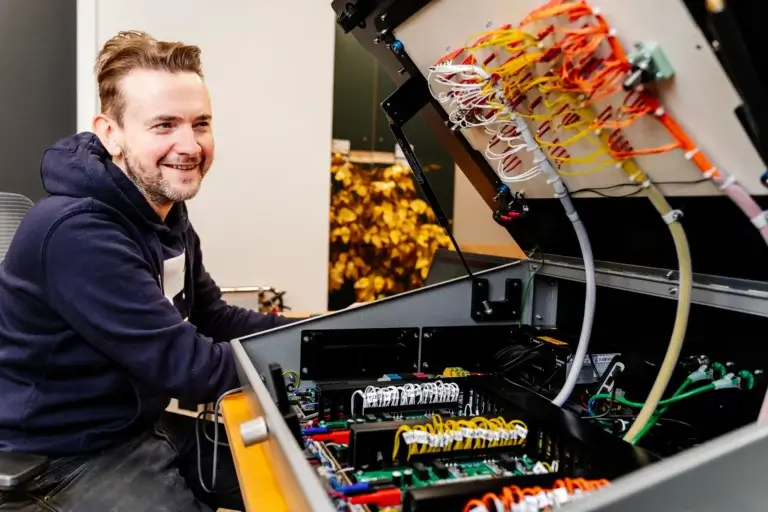Embedded systems play a crucial role in powering smart devices and innovative solutions in today’s digital environment. As a leading electronic design and software development company, ByteSnap Design stands at the forefront of embedded systems development, offering a comprehensive range of services to bring cutting-edge products to life.
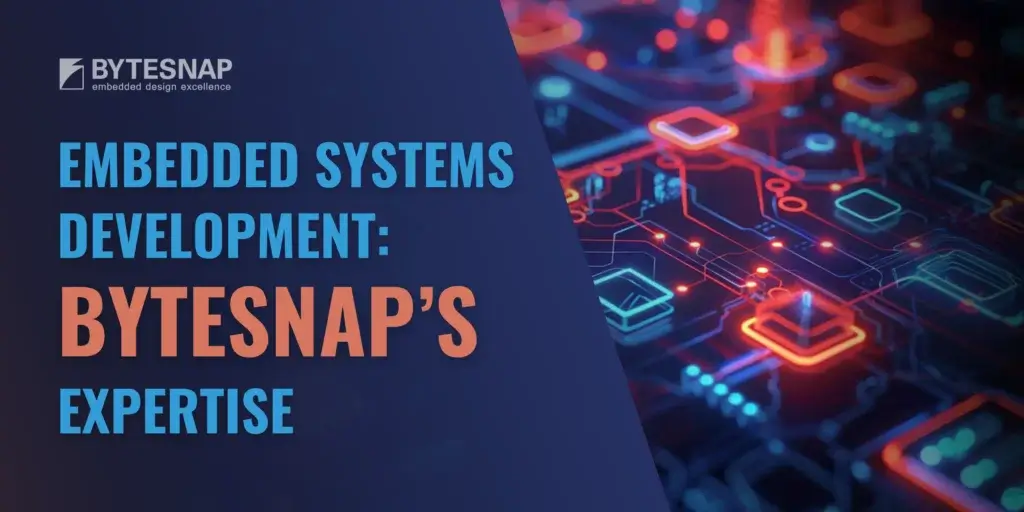
The Essence of Embedded Systems
At its core, an embedded system is a computer system designed for a specific function within a larger mechanical or electrical system. Unlike general-purpose computers, embedded systems are tailored to perform dedicated tasks, often with real-time computing constraints. This specialisation allows for optimisation in size, cost, power consumption, and reliability – crucial factors in many applications.
Hardware Architecture: The Foundation
The journey of embedded systems development begins with hardware architecture. At the heart of most embedded systems lie microcontrollers (MCUs) or microprocessors (MPUs).
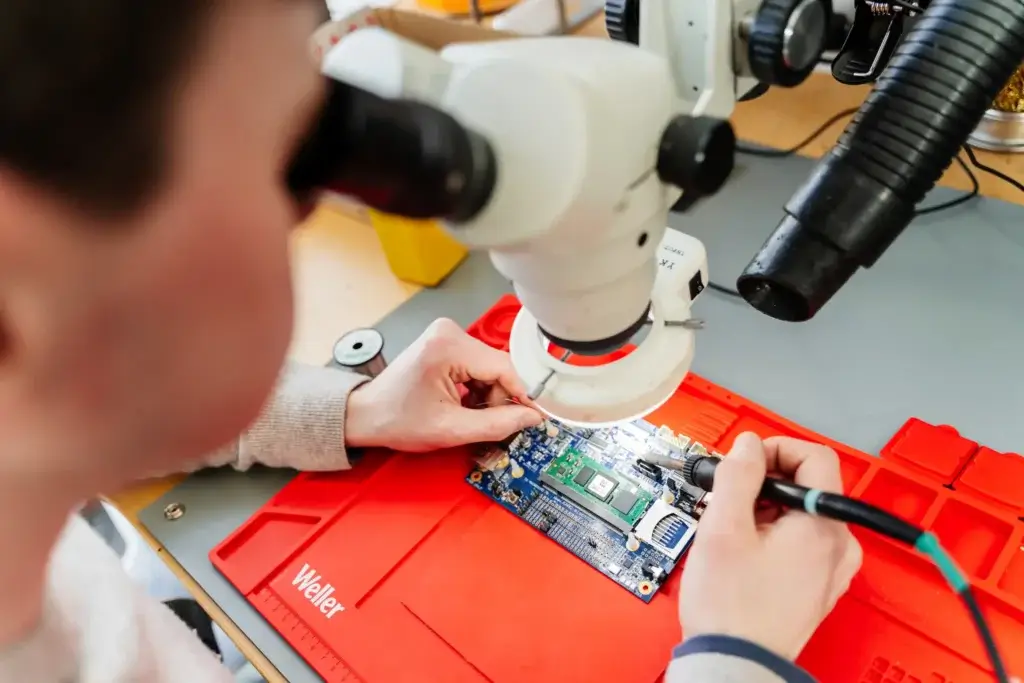
Microcontrollers and Microprocessors
MCUs integrate the processor, memory, and peripherals on a single chip, making them ideal for compact, low-power applications. They’re the go-to choice for devices like smart watches, household appliances, and automotive control systems. MPUs, on the other hand, typically require external components and are used in more complex systems that need higher processing power, such as industrial automation systems or advanced medical devices.
In the realm of MCUs, ARM architectures dominate the market, with the Cortex-M series being particularly popular. For instance, the Cortex-M4 is widely used in applications requiring digital signal processing capabilities. Another architecture gaining traction is RISC-V, an open-source architecture that offers customizability and freedom from licensing fees, appealing to companies looking to design their own custom chips [1].
Memory: The Crucial Resource
Embedded systems utilise various types of memory, each with its own characteristics:
- SRAM (Static RAM): Fast but expensive and power-hungry.
- DRAM (Dynamic RAM): Cheaper and denser than SRAM, but requires refreshing.
- Flash: Non-volatile memory used for program storage.
- EEPROM: Non-volatile memory for storing small amounts of configuration data.
Memory management is crucial in embedded systems due to limited resources. Developers must carefully consider the trade-offs between different types of memory based on the specific requirements of their application [2]. For instance, a system requiring frequent, fast data access might prioritise SRAM, while a system that needs to retain data when powered off would utilise more Flash or EEPROM.
Software Development: Breathing Life into Hardware
While hardware provides the foundation, it’s the software that brings an embedded system to life. Software development for embedded systems presents unique challenges and requires specialised approaches.
Programming Languages: The Tools of the Trade
C and C++ reign supreme in the world of embedded systems development. Their efficiency, low-level control, and small runtime footprint make them ideal for resource-constrained environments. These languages allow direct hardware manipulation, a necessity in many embedded applications.
Here’s an example of C code for toggling an LED on an ARM Cortex-M microcontroller:
#include "stm32f4xx.h"
void delay(int count) {
while (count–);
}
int main(void) {
// Enable clock for GPIOA
RCC->AHB1ENR |= RCC_AHB1ENR_GPIOAEN;
// Configure PA5 as output
GPIOA->MODER |= GPIO_MODER_MODER5_0;
while(1) {
// Toggle LED
GPIOA->ODR ^= GPIO_ODR_OD5;
delay(1000000);
}
}
This code demonstrates direct register manipulation, a common practice in embedded systems programming [3]. It’s a simple example, but it illustrates the low-level control that C provides, allowing developers to interact directly with the hardware.
Operating Systems: Managing Complexity
As embedded systems grow more complex, many developers turn to Real-Time Operating Systems (RTOS) to manage tasks, timing, and resources. FreeRTOS is a popular open-source RTOS that provides features like task scheduling, inter-task communication, and resource management.
Here’s an example of creating a task in FreeRTOS:
#include "FreeRTOS.h"
#include "task.h"
void vTaskFunction(void *pvParameters) {
for (;;) {
// Task code here
vTaskDelay(pdMS_TO_TICKS(1000)); // Delay for 1 second
}
}
int main(void) {
xTaskCreate(
vTaskFunction, // Function that implements the task
“ExampleTask”, // Text name for the task
configMINIMAL_STACK_SIZE, // Stack size in words
NULL, // Task input parameter
tskIDLE_PRIORITY, // Priority of the task
NULL); // Task handle
vTaskStartScheduler(); // Start the scheduler
for (;;); // Should never get here
}
This example demonstrates how to create and schedule a task in FreeRTOS [4]. The RTOS manages the execution of multiple tasks, allowing developers to create more complex systems while maintaining real-time performance.
Development Tools and Environments: Crafting the System
Embedded systems development relies on specialised tools and environments to facilitate efficient coding, debugging, and testing.
Integrated Development Environments (IDEs)
IDEs specific to embedded development often include features like code editing, debugging, and flash programming tools. For example, STM32CubeIDE, which is based on Eclipse, provides a comprehensive development environment for STMicroelectronics’ STM32 microcontrollers.
It includes features like code generation tools, integrated debugging, and peripheral configuration wizards [5].
Debugging Tools: Peering into the System
Debugging embedded systems can be challenging due to limited resources and real-time constraints.
In-Circuit Debuggers (ICDs) allow developers to debug code directly on the target hardware. JTAG (Joint Test Action Group) and SWD (Serial Wire Debug) are common interfaces used for debugging.
Tools like OpenOCD (Open On-Chip Debugger) allow developers to connect to the target hardware and debug their code using familiar tools like GDB.
This capability is crucial for identifying and fixing issues that may only appear on the actual hardware.
Communication Protocols: Connecting the Dots
Embedded systems often need to communicate with other devices or systems, necessitating the use of various communication protocols.
Wired Protocols
Protocols like SPI (Serial Peripheral Interface) and I2C (Inter-Integrated Circuit) are commonly used for short-distance communication between components on a board.
SPI offers high-speed, full-duplex communication, while I2C provides a simple two-wire interface ideal for connecting multiple devices.
Wireless Protocols
For wireless communication, protocols like Bluetooth Low Energy (BLE) and LoRa (Long Range) are popular choices.
BLE is designed for short-range communication with low power consumption, making it ideal for IoT devices.
LoRa, on the other hand, offers long-range communication with low power requirements, suitable for IoT applications in rural or remote areas [6].
Power Management: Extending Battery Life
Power management is crucial in embedded systems, especially for battery-operated devices.
Techniques include:
- Low-power modes: Modern MCUs offer various sleep modes that can drastically reduce power consumption.
- Dynamic Voltage and Frequency Scaling (DVFS): Adjusting the processor’s clock frequency and voltage based on computational needs.
- Power gating: Shutting off power to unused parts of the chip.
Effective power management can significantly extend the battery life of portable devices, a critical factor in many embedded applications [7].
Real-Time Systems Design: Meeting Strict Timing Requirements
Many embedded systems, particularly in areas like automotive, aerospace, and industrial control, have strict timing requirements. These real-time systems must guarantee a response within specified time constraints.
Task Scheduling
Real-time operating systems use various scheduling algorithms to ensure tasks meet their deadlines. Common approaches include:
- Rate Monotonic Scheduling (RMS): A fixed-priority scheduling algorithm where tasks with shorter periods get higher priority.
- Earliest Deadline First (EDF): A dynamic priority algorithm that assigns highest priority to the task with the nearest deadline.
Inter-task Communication
In multi-tasking systems, safe communication between tasks is crucial. Mechanisms like semaphores, mutexes, and message queues are used to synchronise tasks and share data safely, preventing issues like race conditions and deadlocks [8].
Security Considerations: Protecting the System
As embedded systems become more connected, security becomes increasingly important. Key areas of focus include:
- Secure Boot: Ensures that only authenticated code runs on the device, typically using cryptographic signatures.
- Hardware Security Modules (HSM): Dedicated crypto-processors designed to safeguard and manage digital keys for strong authentication.
- Encrypted Communication: Ensuring that data transmitted between devices cannot be intercepted or tampered with.
Security must be considered at all levels of the system, from hardware design to software implementation [9].
Testing and Validation: Ensuring Reliability
Thorough testing is crucial in embedded systems development due to the critical nature of many applications. Key approaches include:
Unit Testing
Frameworks like Unity allow developers to write and run tests for individual components of the system. This helps catch bugs early in the development process.
Hardware-in-the-Loop (HIL) Testing
HIL testing involves connecting the embedded system to a simulator that mimics the physical environment it will operate in.
This allows for comprehensive testing of the system’s behaviour under various conditions without the need for physical prototypes [10].
Standards and Certifications: Meeting Industry Requirements
Embedded systems often need to comply with various industry standards, particularly in safety-critical applications. Some key standards include:
- IEC 61508: Functional Safety of Electrical/Electronic/Programmable Electronic Safety-related Systems
- ISO 26262: Functional Safety for Road Vehicles
- DO-178C: Software Considerations in Airborne Systems and Equipment Certification
These standards often require specific development processes, documentation, and testing procedures to ensure the reliability and safety of embedded systems in critical applications [11].
As we progress further into the era of the Internet of Things (IoT) and edge computing, embedded systems are becoming more prevalent and more complex.
From smart home devices to autonomous vehicles, embedded systems are at the heart of many technological advancements.
Core Embedded Systems Capabilities
ByteSnap’s expertise in embedded systems encompasses a wide range of capabilities, including:
- Hardware design and prototyping
- Embedded firmware development
- Software integration and testing
With a team of skilled engineers and developers, ByteSnap delivers tailored solutions that meet the unique requirements of each project.
Embedded Systems Hardware Design Workflow
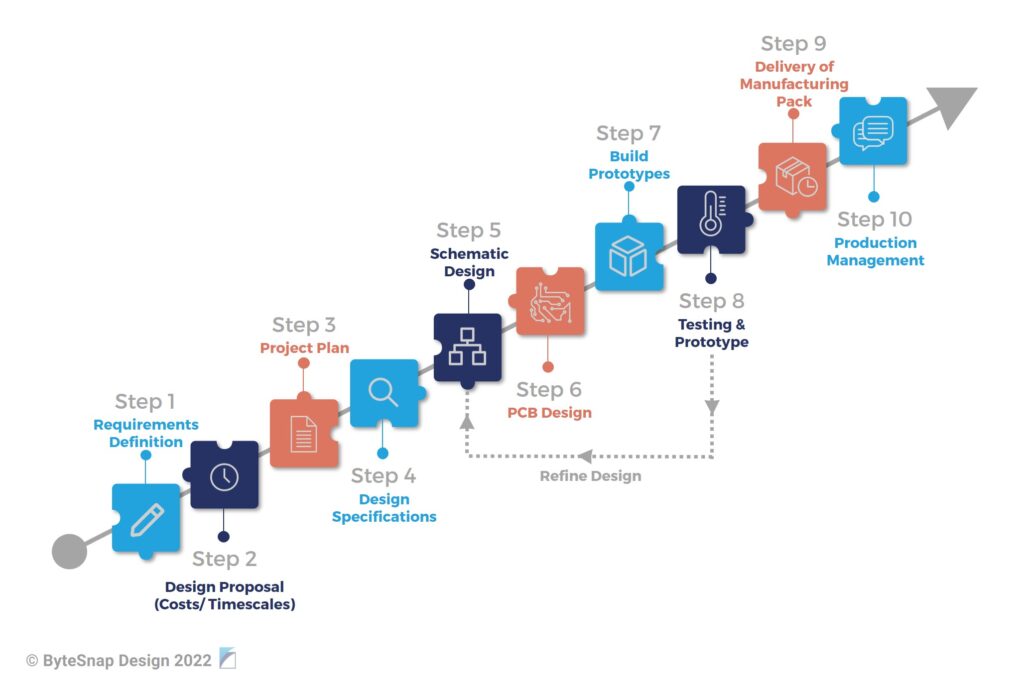
Specialised Embedded Solutions
ByteSnap’s expertise extends to specialised embedded solutions, including:
- IoT and M2M applications
- Electric vehicle charging systems
- User interface development with SnapUI
These specialised solutions enable ByteSnap to cater to diverse industry needs and drive innovation across various sectors.
Embedded Linux Expertise
ByteSnap’s proficiency in embedded Linux development sets them apart in the industry. Their customised Linux-based solutions offer numerous advantages in product development, including:
- Flexibility and scalability
- Cost-effectiveness
- Robust security features
Industry Applications and Case Studies
ByteSnap’s embedded systems expertise has been applied across various industries, including:
- Smart home security products
- Medical device development
- Industrial control systems
One notable case study involves the development of a robust, secure Linux program for remote tracking of medical oxygenators for GCE Healthcare. This project revived their digital health device and opened up new market opportunities.
Tools and Technologies
ByteSnap utilises a range of advanced tools and technologies in their embedded systems development process:
- Integrated Development Environments (IDEs)
- Cross-compilers and assemblers
- Debuggers and flash loaders
- FPGA development tools
Future of Embedded Systems at ByteSnap
ByteSnap remains committed to pushing the boundaries of embedded systems development. Their focus on emerging technologies and trends ensures that clients receive cutting-edge solutions that are future-proof and scalable.
Some areas of future development include:
- Advanced IoT applications
- Artificial Intelligence integration in embedded systems
- Enhanced security features for connected devices
Revolutionising Embedded Systems Development: 6 Essential Services
ByteSnap Design continues to lead the field of embedded systems development with its innovative solutions and expertise. Let’s explore six essential services that showcase ByteSnap’s capabilities in creating cutting-edge embedded systems.
1. SnapUI: Transforming User Interface Development
SnapUI is a powerful user interface development tool specifically designed for embedded systems. This innovative solution offers:
- Intuitive drag-and-drop interface
- Rapid prototyping capabilities
- Cross-platform compatibility
SnapUI accelerates the development process, allowing designers to create visually appealing and functional interfaces for embedded systems across various industries.
2. Medical Device Design: Innovating Healthcare Technology
ByteSnap’s medical device design service caters to the unique challenges of the healthcare industry, offering:
- Expertise in developing software and electronics for various medical applications
- Compliance with medical device standards such as IEC 62304 and ISO 13485
- Solutions for managing obsolescence in existing medical devices
ByteSnap excels at handling obsolescence issues and leverages strong relationships with trusted suppliers in the semiconductor industry to support custom development projects.
A satisfied client in the healthcare technology sector shares:
All very above board; no question marks over what was included and what wasn’t included in the work – it was always very clear.
I’m very confident in ByteSnap’s technical capability; in our experience, ByteSnap always try and understand what we actually are trying to achieve, rather than just doing a shopping list of jobs. As developers, it’s clear that ByteSnap has your best interests at heart as a customer and always strives to find the best solution for you.
I have full confidence in these guys. I would say definitely use ByteSnap.”

3. Charge Point Electronic Design: Powering the Future of Electric Vehicles
The MantaRay Smart Charge Point Communications Controller is a game-changer in the electric vehicle charging industry. This innovative solution offers:
- Seamless integration with existing charging infrastructure
- Real-time communication and data exchange
- Enhanced user experience for EV owners
By implementing this communications controller, charge point operators can improve the overall efficiency and reliability of their networks.
ByteSnap’s EV charger design expertise spans back to 2011 when it’s developed electronics and software for the chargers used at the London 2012 Olympics.
Versinetic, its spin-out EV charger design consultancy, now serves customers across four continents.
Here’s one happy client:
They’re super open-minded and were quick to understand our situation.
They effortlessly translated our business needs into technical requirements.
And Versinetic’s Technical Director is hands down the most experienced engineers we've ever had the pleasure to work with.
Our company would not have existed without Versinetic.” Director, EU charge point manufacturer

4. ATEX and Intrinsic Safety Development: Ensuring Safety in Hazardous Environments
ByteSnap’s expertise in ATEX and intrinsically safe product design is crucial for developing electronics for use in potentially explosive atmospheres. This service offers:
- Advanced knowledge of intrinsically safe product design
- Experience with ATEX regulatory authorities
- Design solutions for Zone 0 environments
ByteSnap’s approach to intrinsic safety design can reduce material costs and increase flexibility in dimensions, making it ideal for handheld devices and industrial sensors.
A client testimonial highlights ByteSnap’s expertise in this area:
ByteSnap’s experience on the ATEX and communication designs plays a critical role in this success.
The design has addressed the challenges of existing corrosion monitoring solutions that our customers face, such as battery failures, obsolescence, high upfront and recurring costs, significant downtime to install.”

5. Automated Electronic Product Design: Streamlining Development
Automated Product Design Service – 5-step workflow.
ByteSnap’s automated electronic product design service reduces overhead for busy engineering team leads and managers and frees up their time for other projects. The service revolutionises the development process by:
- Using advanced CAD tools for accelerated prototyping
- Implementing automated testing and verification procedures
- Streamlining the transition from design to manufacturing
This approach significantly reduces development time and costs while ensuring high-quality, market-ready products.
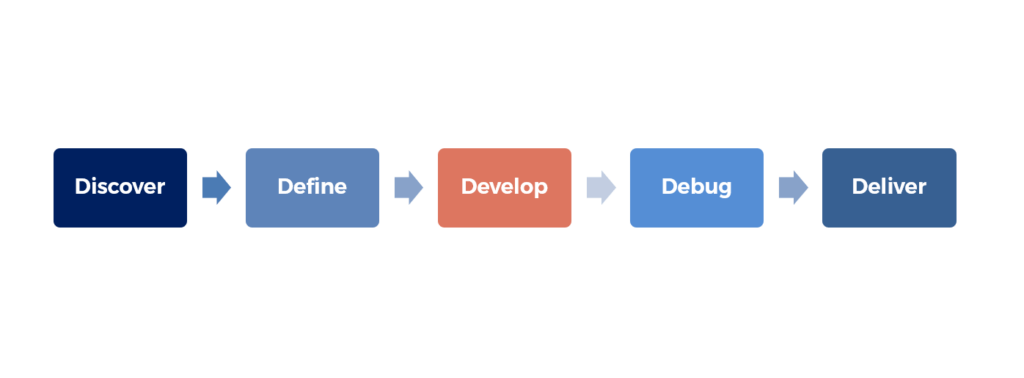
Really pleased that it’s taken just two days from initial enquiry to the start of the development investigation.
I had previously approached four other companies, but they were not as responsive while looking for an immediate support. With ByteSnap, however, it’s been quick calls and the project is now moving.”

6. GStreamer Development: Enhancing Multimedia Capabilities
ByteSnap’s expertise in GStreamer development is crucial for embedded systems requiring advanced multimedia functionality. This service offers:
- Custom GStreamer plugin development
- Optimisation of multimedia pipelines for embedded platforms
- Integration of complex audio and video processing capabilities
By leveraging GStreamer, ByteSnap helps clients create sophisticated multimedia applications for various embedded devices, from smart displays to industrial monitoring systems.
7. IoT and M2M Solutions: Connecting the Digital World
ByteSnap’s expertise in IoT and M2M (Machine-to-Machine) solutions is essential for creating interconnected embedded systems. This service includes:
- Development of custom IoT devices and gateways
- Implementation of secure communication protocols
- Creation of scalable cloud-based back-ends for data management
These solutions enable clients to develop innovative connected products across various industries, from smart home devices to industrial automation systems.
We are pleased to have them on board as a trusted partner for our long-term technical support needs.”

ByteSnap’s Impact on Embedded Systems Development
ByteSnap Design’s suite of development tools and custom design services is revolutionising the embedded systems development landscape. From user interface design and custom M2M development to electric vehicle charging infrastructure, these engineering services are driving progress across several industries.
As the demand for sophisticated embedded systems continues to grow, ByteSnap’s expertise in software development, electronic design, and design solutions positions them as a leader in the field. Their comprehensive approach to embedded systems development ensures that clients across various markets can benefit from cutting-edge technology and efficient development processes.
Conclusion
The field of embedded systems development continues to evolve, with trends like artificial intelligence at the edge, more powerful and energy-efficient hardware, and enhanced security measures shaping its future. As embedded systems become more interconnected and take on more critical roles, the challenges and opportunities for embedded systems developers will only grow.
Whether you’re a seasoned embedded systems engineer or a newcomer to the field, understanding these fundamental aspects of embedded systems development is crucial. As we continue to push the boundaries of what’s possible with technology, embedded systems will undoubtedly play a central role in shaping our technological future.
ByteSnap’s expertise in embedded systems development positions them as a leader in the field of electronic design and software development. Their comprehensive range of services, from hardware design to software integration, enables them to deliver innovative solutions across various industries. With a commitment to continuous innovation and client success, ByteSnap is well-equipped to tackle the challenges of tomorrow’s technological landscape.
For more information on ByteSnap’s embedded systems expertise and how they can help bring your product ideas to life, visit their electronic design services page or explore their case studies for real-world examples of their capabilities.

Dunstan is a chartered electronics engineer who has been providing embedded systems design, production and consultancy to businesses around the world for over 30 years.
Dunstan graduated from Cambridge University with a degree in electronics engineering in 1992. After working in the industry for several years, he co-founded multi-award-winning electronics engineering consultancy ByteSnap Design in 2008. He then went on to launch international EV charging design consultancy Versinetic during the 2020 global lockdown.
An experienced conference speaker domestically and internationally, Dunstan covers several areas of electronics product development, including IoT, integrated software design and complex project management.
In his spare time, Dunstan enjoys hiking and astronomy.
References
- Noergaard, T. (2012). Embedded Systems Architecture: A Comprehensive Guide for Engineers and Programmers. Newnes.
- Catsoulis, J. (2005). Designing Embedded Hardware: Create New Computers and Devices. O’Reilly Media.
- Barr, M., & Massa, A. (2006). Programming Embedded Systems: With C and GNU Development Tools. O’Reilly Media.
- Barry, R. (2016). Mastering the FreeRTOS Real Time Kernel. Real Time Engineers Ltd.
- Yiu, J. (2014). The Definitive Guide to ARM® Cortex®-M3 and Cortex®-M4 Processors. Newnes.
- Ghetie, J. (2008). Fixed-Mobile Wireless Networks Convergence: Technologies, Solutions, Services. Cambridge University Press.
- Benini, L., & De Micheli, G. (2000). System-level power optimisation: techniques and tools. ACM Transactions on Design Automation of Electronic Systems (TODAES), 5(2), 115-192.
- Liu, C. L., & Layland, J. W. (1973). Scheduling algorithms for multiprogramming in a hard-real-time environment. Journal of the ACM (JACM), 20(1), 46-61.
- Paar, C., & Pelzl, J. (2009). Understanding cryptography: a textbook for students and practitioners. Springer Science & Business Media.
- Broekman, B., & Notenboom, E. (2003). Testing embedded software. Addison-Wesley Professional.
- Fowler, K. (2008). Mission-critical and safety-critical systems handbook: Design and development for embedded applications. Newnes.
orem ipsum dolor sit amet, consectetur adipiscing elit. Ut elit tellus, luctus nec ullamcorper mattis, pulvinar dapibus leo.

